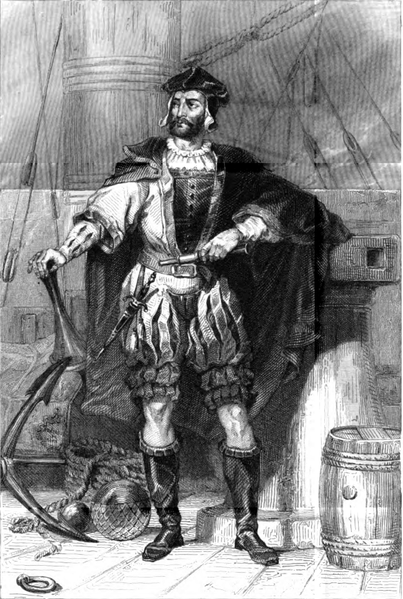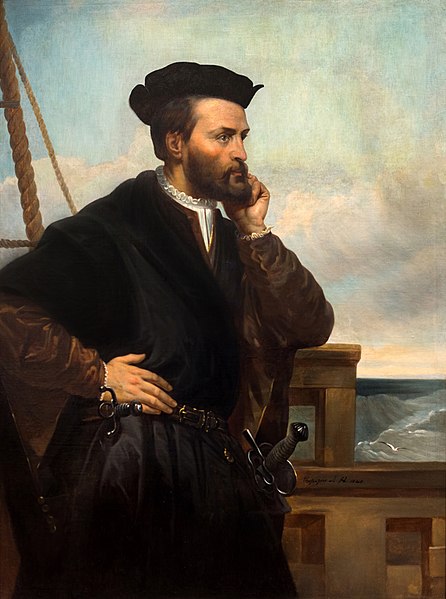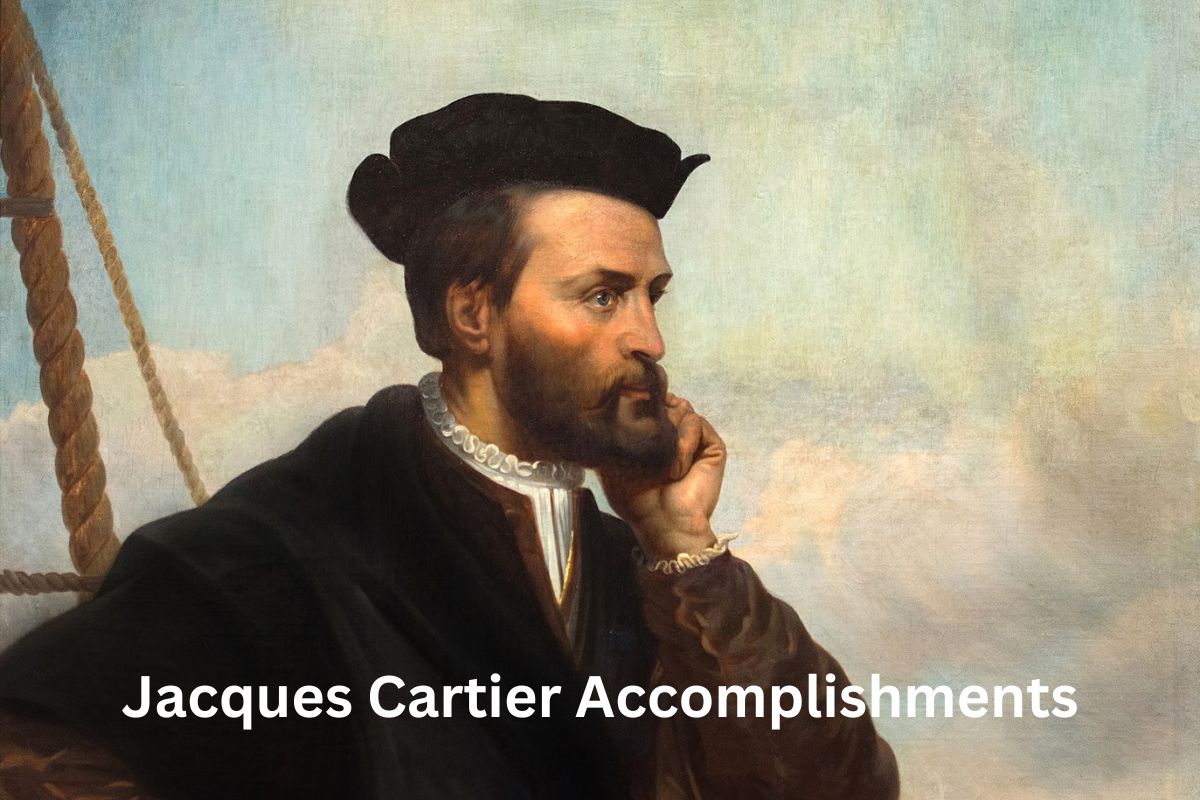Jacques Cartier was a French explorer born around 1491. He is renowned for his voyages to Canada during the 16th century.
Cartier embarked on three expeditions between 1534 and 1542, exploring and mapping various parts of the Canadian Atlantic coast, including the Gulf of St. Lawrence, Newfoundland, and the St. Lawrence River.
He discovered the entrance to the St. Lawrence River, which would become a vital waterway for European exploration and trade in North America.
Cartier claimed the region of Canada for France, establishing French claims in North America and laying the foundation for French colonization and the subsequent establishment of New France.
His interactions with Indigenous Peoples provided valuable insights into their culture and way of life. Cartier’s reports of valuable resources, including furs, fish, and minerals, sparked interest in European trade and settlement in the region.
He made contributions to navigation, documented the natural history of the areas he explored, and left a lasting legacy in Canadian history. Jacques Cartier’s explorations and discoveries played a significant role in the European colonization and shaping of North America.
Accomplishments of Jacques Cartier
1. Explored and mapped Canada
Jacques Cartier embarked on three voyages to Canada between 1534 and 1542. During these expeditions, he ventured into uncharted territories along the Canadian Atlantic coast.
Also Read: Historical Facts About Canada
He meticulously explored and mapped areas such as the Gulf of St. Lawrence, the island of Newfoundland, and the surrounding regions. Cartier’s exploration efforts significantly expanded European knowledge of the North American continent.

2. Discovered the St. Lawrence River
During his first voyage in 1534, Cartier made a monumental discovery when he found the entrance to the St. Lawrence River. This river served as a crucial waterway for future explorers and became the gateway for French colonization and trade in the region.
Cartier’s exploration of the St. Lawrence River opened up new possibilities for further navigation, exploration, and settlement along its shores.
3. Established French claims in North America
One of the most significant accomplishments of Jacques Cartier was his role in establishing French claims in North America. During his voyages, Cartier claimed the region of Canada (specifically the area around present-day Quebec) for France.
Also Read: Accomplishments of Samuel de Champlain
This act laid the foundation for French colonization and the subsequent establishment of New France, a significant French colonial presence in North America. Cartier’s expeditions paved the way for further French exploration, trade, and settlement in the region, shaping the course of Canadian history.
4. Interacted with Indigenous Peoples
Throughout his voyages, Jacques Cartier had numerous interactions with the Indigenous Peoples of the areas he explored, particularly the Iroquoian-speaking communities of the St. Lawrence region.
These encounters provided Cartier with insights into the culture, customs, and way of life of the native populations. He documented his interactions, learning about their social structures, religious beliefs, and economic practices.
These meetings with Indigenous Peoples contributed to the growing understanding of the diversity of human societies in the Americas and their impact on European perceptions of the New World.

5. Introduced the word “Canada” to Europe
During his second voyage in 1535, Cartier encountered the Iroquoian village of Stadacona, which he referred to as “Canada” in his reports. The name “Canada” derived from the Iroquoian word “Kanata,” meaning village or settlement.
Cartier extended the term “Canada” to refer to the entire region he explored. His use of the word introduced it to Europe and played a crucial role in popularizing the name for the region that would eventually become the country of Canada.
6. Discovered valuable resources
During his expeditions, Jacques Cartier discovered and reported on various valuable resources in the Canadian region. He encountered a thriving fur trade, particularly with the Indigenous Peoples, who prized beaver pelts for their fur.
Cartier’s reports of the abundance of furs in the region sparked interest among European traders and established a foundation for the fur trade that would become a significant economic activity in North America.
Additionally, Cartier observed the abundance of fish, particularly cod, in the waters off Newfoundland. This knowledge contributed to the development of lucrative fishing industries in the area.
Cartier’s explorations also revealed the presence of minerals such as iron ore and copper, indicating potential wealth in the region and stimulating further interest in its resources.
7. Advanced navigational techniques
Jacques Cartier’s voyages contributed to advancements in navigational techniques. He employed various navigational instruments such as the astrolabe and quadrant to determine latitude and longitude, enabling more accurate mapping and exploration.
Cartier’s use of these instruments, along with his meticulous recording of navigational details, improved the understanding of navigation in the challenging waters of the North Atlantic and provided valuable knowledge for future explorers.
8. Promoted further exploration
Cartier’s reports and descriptions of his voyages generated significant interest in further exploration of the North American continent. His accounts of the lands he discovered, the resources he encountered, and the potential for trade and colonization sparked the curiosity of European powers.
Cartier’s expeditions, particularly his exploration of the St. Lawrence River, served as a catalyst for subsequent expeditions by other explorers, including Samuel de Champlain, who founded Quebec City in 1608.
9. Documented natural history
During his voyages, Jacques Cartier took a keen interest in documenting the natural history of the areas he explored. He made detailed observations of the flora, fauna, and ecosystems he encountered.
Cartier’s records and drawings provided valuable insights into the biodiversity of North America, including descriptions of plants, animals, and geographical features. His documentation contributed to expanding knowledge of the New World’s natural history and laid the groundwork for future scientific investigations and studies.
10. Left a lasting legacy in Canadian history
Jacques Cartier’s explorations and achievements left a lasting legacy in Canadian history. His voyages played a pivotal role in establishing French claims to North America, leading to the colonization and eventual formation of New France.
The French presence in Canada, influenced by Cartier’s explorations, had a profound impact on the culture, language, and political landscape of the country. Today, Cartier is recognized as one of the key figures in the early European exploration of Canada and is celebrated as a significant figure in Canadian history.
